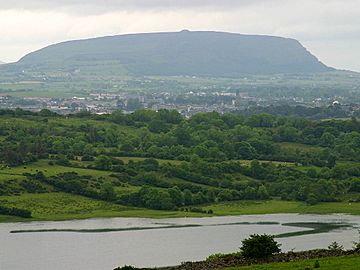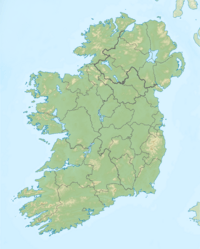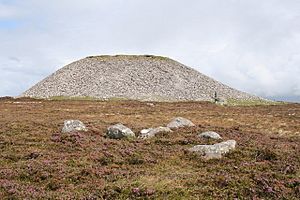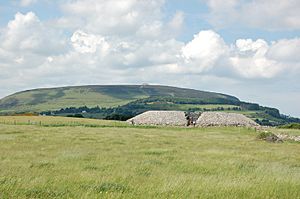Knocknarea facts for kids
Quick facts for kids Knocknarea |
|
|---|---|
| Cnoc na Riabh | |
 |
|
| Highest point | |
| Elevation | 327 m (1,073 ft) |
| Prominence | 312 m (1,024 ft) |
| Listing | Marilyn |
| Geography | |
| OSI/OSNI grid | G626346 |
| Topo map | OSi Discovery 16, 25 |
| Geology | |
| Mountain type | limestone |
| Climbing | |
| Easiest route | Hike |
Knocknarea is a big, noticeable hill in County Sligo, Ireland. It's located west of Sligo town and stands 327 metres (1,073 ft) tall. This hill looks amazing with its steep limestone cliffs. It sits on the Cúil Irra peninsula, looking out over the Atlantic Ocean.
At the very top of Knocknarea, you'll find one of Ireland's largest ancient stone piles, called a cairn. This famous cairn is known as Queen Maeve's Cairn. People believe it holds a Neolithic (New Stone Age) passage tomb inside.
Knocknarea is also special because it overlooks the Carrowmore tombs. Experts think the hill was once part of an important ancient area used for special ceremonies.
What's in a Name?
The name Knocknarea comes from an old Irish name. "Knock" means "hill" in Irish. However, what the rest of the name means is a bit of a mystery!
The official Placenames Database of Ireland suggests the Irish name is Cnoc na Riabh. This means "hill of the stripes."
Other ideas for the name include Cnoc na Riaghadh, which means "hill of the executions." Some also think it could be Cnoc na Riogha ("hill of the kings") or Cnoc na Ré ("hill of the moon").
Queen Maeve's Cairn
On top of Knocknarea, there's a huge stone mound called a cairn. It's about 55 metres (180 ft) wide and 10 metres (33 ft) high. This makes it one of the biggest cairns in Ireland, apart from those at Brú na Bóinne in County Meath.
Even though archaeologists haven't dug into it, the cairn looks a lot like a classic passage tomb. It has a flat top, and you can see some large stones, called kerbstones, around its base. People believe it was built around 3000 BCE, which is about 5,000 years ago!
Archaeologist Stefan Bergh thinks the stones for the cairn might have come from a large hollow area west of the cairn. In Irish, the cairn is called Meascán Méabha or Miosgán Meadhbha. This means "Maeve's lump or heap." In English, it's known as Maeve's Cairn or Maeve's Tomb.
Méabh is a famous queen from Irish mythology. She was a powerful ruler of Connacht and is thought to have originally been a goddess.
This ancient cairn is a protected National Monument. This means it's very important and should be looked after. In recent years, experts have worried that people climbing on the cairn are damaging it. Moving stones or leaving marks can harm this old tomb. Irish stories say it's bad luck to damage these ancient sites.
Other Ancient Sites
There are also other ancient monuments on the top of Knocknarea. Most of these seem to have been smaller passage tombs or burial mounds. The biggest one is a partly ruined tomb about 50 meters north of Maeve's Cairn.
These tombs are generally lined up from North to South. They might have been built to face the Carrowmore passage tombs, which are to the east of Knocknarea. Some of these smaller tombs were damaged by people digging them up in the 1800s.
Knocknarea was likely a very important place for meetings and ceremonies during the Stone Age. The entire eastern side of the hilltop is surrounded by a long earth wall. This wall is about 1-kilometre (0.6 mi) long, 2 metres (2 yd) wide, and 0.8 metres (3 ft) tall.
Archaeologists have found signs of old hut sites inside this walled area. They have also found many pieces of stone left over from making tools. This shows that people lived and worked here a very long time ago.
The area around Sligo Bay has many ancient remains. From Knocknarea, you can see other important sites like Croaghaun Mountain, Carrowkeel Megalithic Cemetery, and Cairns Hill. The Carrowmore passage tomb cemetery is right at the eastern foot of Knocknarea.
Images for kids





